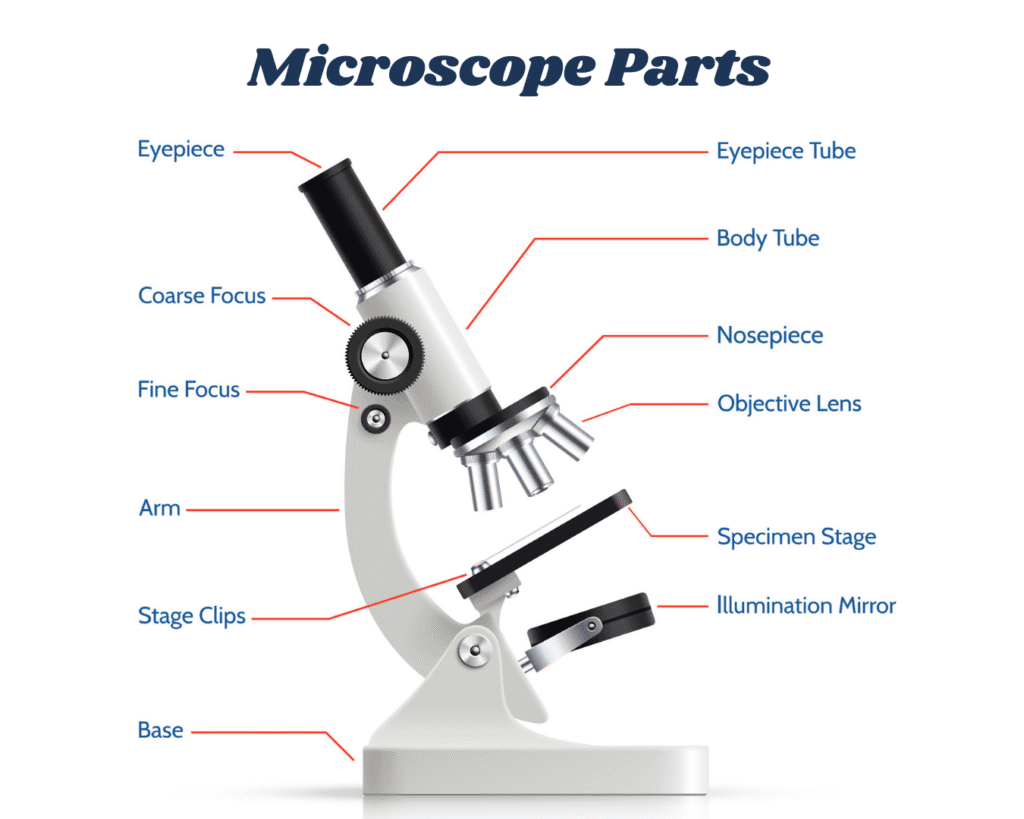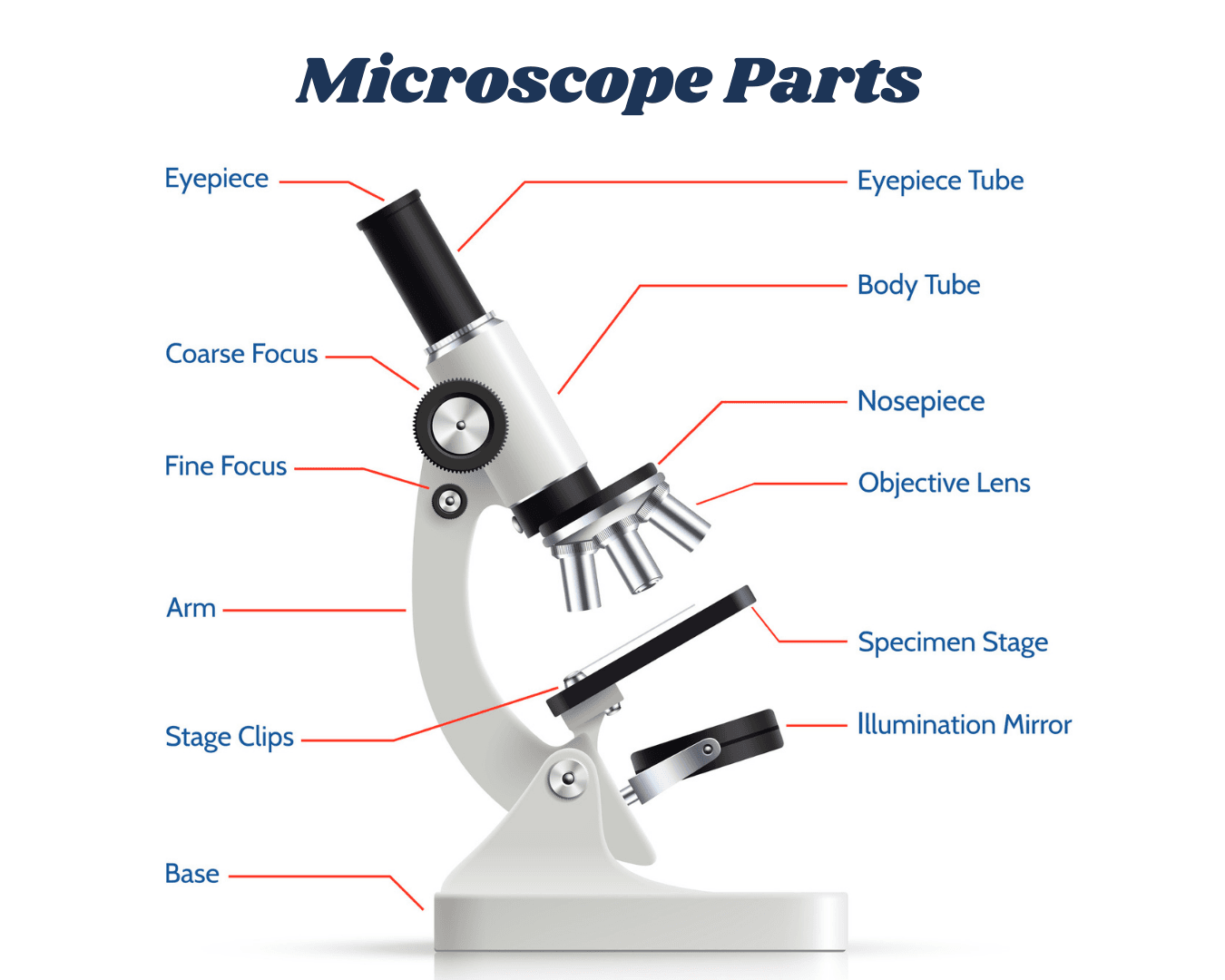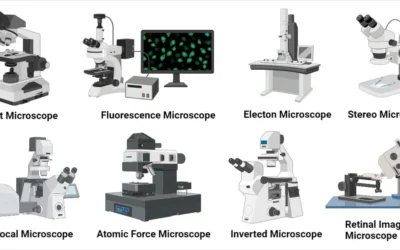Introduction
Ever wondered how scientists are able to see bacteria, cells, or even the tiniest structures invisible to the naked eye? The answer lies in the microscope. But here’s the thing: a microscope isn’t just one tool; it’s a collection of carefully designed parts working together.
If you understand these parts, you’ll know exactly how this incredible instrument does its magic. In this guide, we’ll break down every key component of a microscope, its function, and how all the microscope parts combine to give us a window into the unseen world.
The Three Main Categories of Microscope Parts
Microscopes are generally made up of three main categories of parts:
- Mechanical parts – provide support and structure.
- Optical parts – responsible for magnification.
- Illuminating parts – ensure the specimen is visible.
Let’s explore each category in detail.

Mechanical Parts of a Microscope
Base
The base is the microscope’s foundation. It holds the structure steady and ensures stability during use. Without it, vibrations would distort the image.
Arm
The arm connects the base to the head. It also acts as the handle for carrying the microscope safely. Always hold the microscope by the arm and base together when transporting.
Stage
The stage is the flat platform where the specimen slide is placed. Modern microscopes often come with a mechanical stage that allows smooth movement of the slide in different directions.
Stage Clips or Stage Holder
These clips secure the specimen slide in place so it doesn’t shift while you’re adjusting focus.
Nosepiece (Revolving Turret)
This rotating part holds the objective lenses. By turning it, you can easily switch between magnification levels such as 4x, 10x, 40x, or 100x.
Coarse and Fine Adjustment Knobs
- Coarse adjustment knob – brings the object roughly into focus.
- Fine adjustment knob – fine-tunes clarity and sharpness.
Both work together for precise focusing, especially at higher magnifications.
Body Tube or Head
This part holds the eyepiece and aligns it with the objective lenses, ensuring the optical pathway is correct.
Optical Parts of a Microscope
Eyepiece (Ocular Lens)
Located at the top, the eyepiece is where you look through. Most eyepieces magnify at 10x or 15x. Some advanced microscopes allow interchangeable eyepieces for different magnification ranges.
Objective Lenses
The most important magnifying lenses of the microscope are usually mounted on the nosepiece. Typical strengths include:
- 4x (scanning lens)
- 10x (low power lens)
- 40x (high power lens)
- 100x (oil immersion lens)
When combined with a 10x eyepiece, these lenses give total magnifications of 40x, 100x, 400x, and 1000x.
Condenser Lens
Positioned beneath the stage, the condenser focuses light onto the specimen. A well-adjusted condenser improves both clarity and resolution.
Diaphragm (Iris)
The diaphragm controls how much light passes through the specimen, similar to how your eye’s pupil adjusts to brightness. Adjusting it changes contrast and detail visibility.
Illuminating Parts of a Microscope
Mirror (in Older Models)
Before built-in lights, microscopes relied on a mirror to reflect external light onto the specimen.
Built-in Light Source (LED or Halogen)
Modern microscopes use LED or halogen bulbs for steady, consistent illumination. LED lights are energy-efficient and long-lasting, while halogen provide bright, natural light.
Additional Parts and Accessories
- Mechanical Stage Controls – knobs for moving the slide without touching it directly.
- Dust Cover – protects the microscope when not in use.
- Filters – improve contrast and highlight specific specimen details.
Compound vs. Stereo Microscope Parts
- Compound Microscopes – designed for very small specimens like bacteria and cells; use multiple lenses for high magnification.
- Stereo Microscopes – provide a 3D view of larger objects at lower magnification, such as insects, plants, or electronic circuits.
Digital Microscopes and Their Unique Parts
Digital microscopes replace the traditional eyepiece with a camera and display screen. Instead of peering into an ocular lens, you can view specimens directly on a monitor. They often come with USB or wireless connectivity, making them ideal for teaching, documentation, and sharing results.
Functions of Microscope Parts
Every part of a microscope serves a unique purpose:
- Lenses – magnify tiny details.
- Adjustment knobs – sharpen clarity.
- Illuminators and condensers – provide bright, clear views.
Together, they create a detailed image of the specimen.
How Microscope Parts Work Together
Here’s how light travels inside a microscope:
- Light shines from the source (or mirror).
- The condenser focuses light onto the specimen.
- Light passes through the specimen into the objective lens, where the first magnification occurs.
- The eyepiece lens magnifies the image further for viewing.
This seamless interaction between optical, mechanical, and illuminating parts brings the microscopic world to life.
Proper Care and Handling of Microscope Parts
- Always hold the microscope by the arm and base.
- Use only lens paper for cleaning optical parts.
- Store the microscope covered and in a dry place.
- Avoid touching the lenses with fingers—they leave oils that reduce clarity.
Common Problems with Microscope Parts
- Blurry images → clean the lens or use the fine adjustment knob.
- Slide shifting → stage clips may be loose.
- No light → check the bulb or mirror alignment.
- Uneven brightness → adjust diaphragm and condenser.
Importance of Learning Microscope Parts in Education
Understanding microscope parts is essential in biology, medicine, and research. Students who master the parts can focus on experiments instead of struggling with the equipment.
Future Innovations in Microscope Parts
The field of microscopy continues to evolve with exciting innovations:
- AI-assisted focusing systems for instant sharpness.
- Digital microscopes that connect to smartphones and tablets.
- Enhanced imaging software for automatic specimen recognition.
These advancements make microscopes more powerful, user-friendly, and accessible to students and professionals alike.
Conclusion
Microscopes may look intimidating at first, but once you understand their parts, they’re surprisingly straightforward. Each component plays a unique role, and together they open doors to the unseen world.
Whether you’re a student, researcher, or simply curious, knowing the parts of a microscope and their functions helps you use this tool effectively and appreciate the beauty of science even more.
FAQs
1. What are the three main parts of a microscope?
Mechanical, optical, and illuminating parts.
2. Why is the fine adjustment knob important?
It fine-tunes focus, making the specimen crystal clear.
3. Do all microscopes have built-in lights?
No. Older microscopes used mirrors, but most modern ones use LED or halogen lights.
4. What is the strongest objective lens on a standard microscope?
The 100x oil immersion lens, used for high-detail studies of bacteria and cells.
5. How should I clean a microscope lens?
Always use special lens paper and cleaning solution—never tissue or cloth.


0 Comments